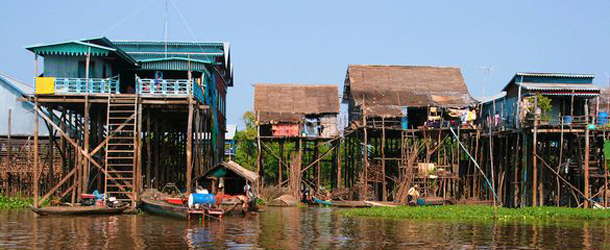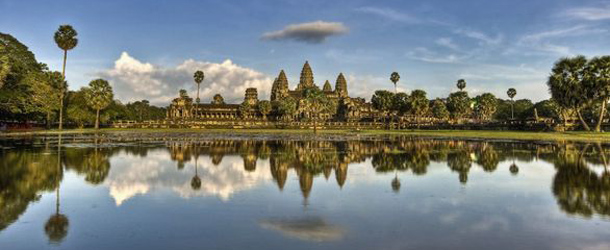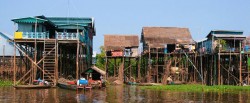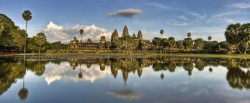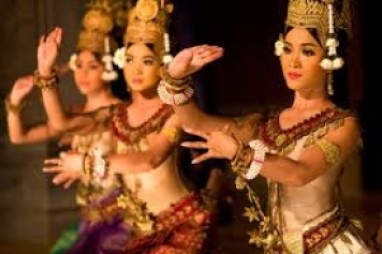Angkor Through the Ages
info@handspan.comOverview
An authentic exploration trip. A veritable pleasure for History and Nature lovers. A very special chronological encounter with the majestic Angkor Wat complex which will allow us to understand the architectural evolution of the ensemble and also how each of the successive kings left their mark during their respective reigns on the Khmer empire.
The temples of Angkor are a profound experience, as few sights on earth can match the majesty of Angkor Wat, the nature unleashed at Ta Prohm or the mysterious faces of the Bayon. We will be also travelling to the old capital of Koh Ker to experience one of our signature temple safaris a remote temple complex, visiting the sleeping jungle-clad ruins of Beng Mealea, a prototype for Angkor Wat and discovering the daily life on the closeby floating villages on "the Great Lake", the Tonle Sap.
Highlights
- An insider experience of Angkor Temples, one of the man-made wonders ever built.
- Getting to know the Khmer architecture, History, traditions and symbolism of such a transcendental civilization.
- A cruise on a small traditional wooden boat around the genuine floating village of Kompong Pluk.
- An easy jungle trek around the mystical Kbal Spean to explore its impressive ancient river carvings.
Day 1 Roluos Temples & Kompong Pluk, Tonle Sap Lake
Meals: lunch at Sala Roluos | Accommodation: in Siem Reap
We will travel back in time to one of the earliest capitals in the Angkor area, Hariharilaya, now known as Roluos Group. We will begin with the brick temple of Lolei, originally set on an island in the center of the Indratataka baray (reservoir). This temple has some well-preserved sandstone carvings and the vast stone doors are carved from a single piece of stone. We will continue to Preah Ko (sacred cow), named in honor of Shiva’s mount, Nandin. This temple owes more to the pre-Angkorian brick sanctuaries of Cambodia’s earlier Chenla Empire than the sandstone behemoths that came later. Originally coated in stucco and painted, there is still some of the ancient plaster visible on the rear towers. Finally, we will encounter Bakong, the earliest of the Temple Mountains, which later became the signature of Khmer kings. It is a giant pyramid, its cardinal points marked by giant elephants. We climb to the summit for views over the surrounding countryside.
At noon, we will enjoy a Khmer lunch at a beautiful wooden home (Sala Rolous) designed by the renowned Khmer architect Hok Sokol, this two-story house is a striking contemporary take on the traditional Khmer house.
In the afternoon, we will board a small wooden boat to Kompong Pluk. Cruising down a narrow waterway, we enter this medieval floating village, where the houses stand atop stilts as much as seven meters above the water. Everything lives on the water here: pigs, dogs, crocodiles, and people, all jockeying for space in this incredible floating town. We will explore the local wat here, as well as some of the traditional Khmer houses on stilts. There is also the opportunity to stop at a local floating café or restaurant amid the flooded forest. We will return to Siem Reap by road.
Day 2 Koh Ker & Beng Mealea
Meals: not included | Accommodation: in Siem Reap
Today we will head to the lost temple of Beng Mealea, the titanic of temples, a slumbering giant lost for centuries in the forests of Cambodia. It is the most accessible of Angkor’s lost temples, a mirror image of Angkor Wat, but utterly consumed by the voracious appetite of nature. Constructed by Suryavarman II (1113-1150), the builder of Angkor Wat, the forest has run riot here and it is hard to get a sense of the monument’s shape amid the daunting ruins, like a sort of Indiana Jones experience. For those who want a more gentle adventure, there is also a sturdy wooden walkway running right into the heart of the temple. It is also possible to visit a nearby Angkor-era quarry from where the stone was cut to build these massive monuments.
We then will get into the bush to the remote Angkor capital of Koh Ker. The history of Cambodia is riven with dynastic spats and political intrigue and one of the most memorable came in the 10th century when Jayavarman IV (928-942) fell out with his family, stormed off to the northwest and established the rival capital of Koh Ker. Although the capital for just 15 years, Jayavarman IV was determined to legitimize his rule through a prolific building program that left a legacy of 30 major temples and some gargantuan sculpture that is on display in the National Museum in Phnom Penh.
We will also visit Prasat Thom, a seven-story step pyramid that seems more Mayan than Khmer, which has commanding views over the surrounding forest. Nearby is Prasat Kratom or Red Temple, named after the pinkish Banteay Srei-style stone from which it is built.
There are many more temples in the area, including the five towers of Prasat Ling, each enclosing a giant linga or fertility symbol, the biggest and best found anywhere in Cambodia.
Day 3 Kbal Spean & Banteay Srei
Meals: not included | Accommodation: in Siem Reap
Kbal Spean will be awaiting us after our drive direction North. The original ‘River of a Thousand Lingas’, Kbal Spean is an intricately carved riverbed deep in the foothills of the Cambodian jungle. The river flows down to the Tonlé Sap Lake, and in ancient times its holy waters breathed life into the rice fields of the empire via the most complex irrigation system the world had ever seen. The Khmers venerated its limestone bed with a riot of carvings, including the delicate deities Vishnu and Shiva with their consorts. Lingams are phallic representations sacred to Hindus as fertility symbols and hundreds, perhaps thousands, are carved into the bedrock here. The carvings were only rediscovered in 1969 when the French researcher Jean Boulbet was shown the river by a local hermit. A trip to Kbal Spean is one of the easiest ways to experience a short jungle trek in the Angkor area, as it is a steady but scenic climb to reach the river carvings. The path winds its way through knotted vines and big boulder formations and occasionally offers big views over the surrounding jungle. There is also a small waterfall below the carved riverbed, perfect for cooling off after the hot climb.
We will continue to Banteay Srei, Angkor’s ultimate art gallery. This petite pink temple is the jewel in the crown of Angkor-era sculpture. The elaborate carvings here are the finest found in Cambodia, indeed the name of the temple is translated as ‘Fortress of the Women’ since the intricate detail here is considered too fine for having been carved by the hands of a man. Originally believed to date from the latter part of the Angkor period, inscriptions at the site suggest it was built by a Brahman in 967. However, some architectural historians have suggested that the inscriptions may date from an earlier structure on this site and the temple is in fact later, marking a high-water mark in Khmer sculpture.
Day 4 Angkor Wat Sunrise. Preah Khan, Neak Poan & Ta Som
Meals: not included | Accommodation: in Siem Reap
Rising at the crack of dawn, we will journey to the Mother of all temples, Angkor Wat. Believed to be the world's largest religious building, the temple is the perfect fusion of symbolism and symmetry and a source of pride and strength to all Khmers. Built-in the 12th century by King Suryavarman II, this is the most famous temple at Angkor.
We will stay at Angkor Wat to enjoy a picnic breakfast. As the crowds return to their hotels, we will venture into Angkor Wat to be able to appreciate all its magnificence. We will begin by unraveling the mysteries of the bas-reliefs that tell tales from Hindu mythology and of the glories of the Khmer empire. Stretching for almost one kilometer, these intricate carvings are a candidate for the world’s longest unbroken piece of art. Following in the footsteps of the devout and the destructive before us, we then continue to the upper levels of the inner sanctuary. The final steps to the upper terrace of Angkor are the steepest of all, as pilgrims were supposed to stoop on their pilgrimage to encounter the Gods. We finally find ourselves by the pinnacle, the sacred heart of Angkor Wat, a blend of spirituality and symmetry so perfect that few moments will measure up.
We will head later to the mighty temple of Preah Khan or 'Sacred Sword', built by King Jayavarman VII in the late 12th century. Sister temple to Ta Prohm, the cruciform corridors here are impressive, as well as some wonderful carvings adorning the walls, including the spectacular hall of dancers. Look out for the curious two-story structure that is almost Grecian in inspiration. This is one of the few temples originally dedicated to Buddhism and Hinduism. The original eastern entrance was for Mahayana Buddhists, while the other cardinal points represented the Hindu trinity of Shiva, Vishnu, and Brahma.
Our next goal will be the elegant curves of Neak Poan, its ornamental fountain, and its series of elaborate spouts with heads of lions and elephants. Originally, Neak Poan was on an island at the center of a vast baray (reservoir), known as Jayatataka or reservoir of Jaya, which is once again filled with water. Note that it is not possible to enter the central area of this temple during high waters in the wet season.
We will end our exploration with a visit to Ta Som, one of Jayavarman VII’s smaller creations, but one that boasts a striking strangler fig tree smothering the East Gate of the temple. There is an optional sunset at the royal cremation temple of Pre Rup or the royal bathing pond of Sra Srang if the weather conditions are favorable.
Day 5 Ta Prohm & Angkor Thom
Meals: not included | Accommodation: in Siem Reap
Early in the morning, we will travel to Ta Prohm. Ta Prohm has been abandoned to the elements, left as it was ‘discovered’ by French explorer Henri Mouhot in 1860, the tentacle-like tree roots here are slowly strangling the surviving stones. After soaking up the unique atmosphere of Ta Prohm, we will continue to the giant pyramid of Takeo, one of the highest temples in the Angkor area. Built at the end of the 10th century, it was never completed. We walk to the first great Buddhist monastery in Cambodia, Banteay Kdei, built-in 1186 by Jayavarman VII. We explore its extensive corridors and elegant sculptures. Although it is in a ruinous state, it often receives far fewer visitors than nearby Ta Prohm, giving it a serene atmosphere. We will then visit the royal bathing pond of Sra Srang.
Time for the immense walled city of Angkor Thom in the afternoon. Following the occupation of Angkor by the Chams from 1177 to 1181, the new king decided to build an impregnable fortress at the heart of his empire. The scale is simply staggering and we will feel immediately overwhelmed by the audacity of Jayavarman as soon as we arrive at the city’s gates. The causeway is lined by an intricate bridge depicting the Churning of the Ocean of Milk from Hindu mythology in which the devas (gods) and asuras (devils) play tug of war with a naga (seven-headed serpent) to obtain the elixir of immortality. Located at the exact center of Angkor Thom, the Bayon is an eccentric expression of the creative genius and inflated ego of Cambodia’s most celebrated king. Its 54 towers are each topped off with the four faces of Avalokiteshvara (Buddha of Compassion), which bear more than a passing resemblance to the king himself. These colossal heads stare down from every side, exuding power and control with a hint of compassion, like the features required to keep a hold of such a vast empire.
Afterward, we will visit the Terrace of Elephants, originally used as a viewing gallery for the king to preside over parades, performances, and traditional sports. At the southern end lies the Baphuon, once of the most beautiful temples at Angkor, dating from the reign of Uditayavarman in the 11th century. It has undergone a massive renovation by the French and is now once again open for viewing.
Our Grand Circuit will finish at the Terrace of the Leper King. This intricately carved platform was the royal crematorium and the statue that was originally thought to be the leper king is now believed to be Yama, the god of death.
Price per person based on a group tour
|
Validity |
Price per person based on group of 2 pax |
|
Jan 2023 - Dec 2023 |
USD 574 |
|
Jan 2024 - Dec 2024 |
USD 631 |
* Would you like to adapt the itinerary, accommodation or any activity as per your needs and preferences? Then just forward us your comments at info@handspan.com.
* Special prices for groups of more than 2 people and for children, and the possibility to connect the tour with other stages of your trip around Indochina, by contacting us.
* A private trip for a solo traveller is also available with a surcharge.
Inclusion:
- Transportation with experienced drivers as stated.
- Meals as specified.
- All entrance fees, visits, and activities are mentioned in the program.
- The services of experienced local English-speaking guides.
- VAT and other taxes.
Exclusion:
- Accommodation.
- Flights and visas.
- Personal travel Insurance.
- Child or adult in triple sharing room
- Beverages, gratuities, and personal expenses.
- Supplements in peak season.
__logo.png)
__hanoi-water-puppets.jpg)
__angkor-wat-blue-reflections.jpg)
__vientiane-buddha-park-monks.jpg)
__bagan-dhammayazika-dusk.jpg)

